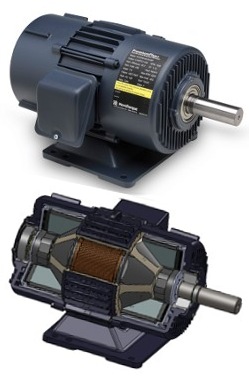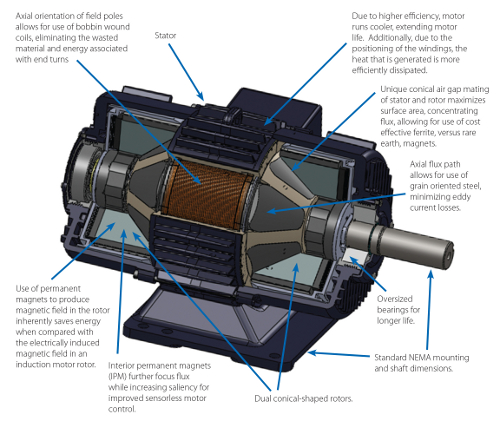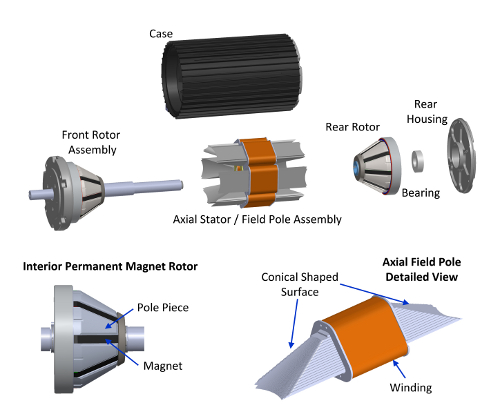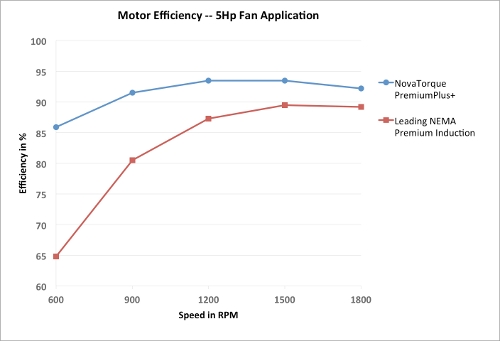 |
| September 17, 2013 | Volume 09 Issue 35 |
Designfax weekly eMagazine
Archives
Partners
Manufacturing Center
Product Spotlight
Modern Applications News
Metalworking Ideas For
Today's Job Shops
Tooling and Production
Strategies for large
metalworking plants
Engineer's Toolbox:
Maybe it's your motor that could be more efficient
By Shams Shaikh, NovaTorque

Lab testing of the NovaTorque motor validates and documents efficiency results exceeding those mandated by NEMA Premium standards.
NEMA Premium-efficiency induction motors are considered by many to be the standard for integral-horsepower, general-purpose, AC induction motors. While these motors raise the bar for energy efficiency, continuing improvement is both possible and cost effective. The latest design innovations in motor-driven systems can not only further improve equipment efficiency and performance, but they can bring benefits to bear such as higher power density, lower operating temperatures, and longer life.
The U.S. Department of Energy says efficiency improvements can provide as much as a 60 percent energy savings in some applications. Industry and business have gotten the message and want to expand energy efficiency as a means to reduce power bills and carbon emissions.
In the U.S., the Energy Independence and Security Act (EISA) mandates upgrades to full-load efficiencies. EISA-mandated full-load efficiency standards apply to general-purpose, three-phase AC industrial 1-hp to 500-hp motors.
Within the European Union, The Committee of European Manufacturers of Electrical Machines and Electronic Power (CEMEP) developed its efficiency classification for 1-hp to 500-hp motors (0.75 kW to 375 kW).
Today's installed process-industry equipment base presents many opportunities for additional energy-efficiency efforts. These include line-powered equipment such as fans, pumps, compressors, mixers, grinders, conveyors, packaging, and labeling equipment; feeders; stackers; and converting equipment. It also includes battery-operated mobile equipment, such as electric vehicles, lift trucks, and golf carts.
In many applications, efficiency can be improved by using a variable frequency drive (VFD) that adjusts motor speed based on load-demand requirements, thus saving energy. In a fan application, for example, a VFD can decrease speed on a 1,800-rpm motor during off-peak hours by 20 percent, thereby reducing power usage by 50 percent.
While a VFD saves energy in many applications, connecting it to a motor doesn't improve the motor's efficiency: An 89 percent-efficient motor with a VFD is still, at best, only 89 percent efficient. To further improve motor systems, a more efficient motor must be used.
How efficient is an AC induction motor?
The simplest and most common motor applied to commercial and industrial applications is the AC induction motor. Construction consists of a stator with windings and a "squirrel-cage" rotor. Induction motor efficiency varies by design and power output. An efficiency rating is provided on the motor's nameplate.
For induction motors, nameplate efficiency is expressed at the motor's rated point. For typical designs, the motor's efficiency is highest near the motor's rated point and declines as the operating speed or load moves away from this point. For example, when operating a 3-hp, 89.5 percent-efficient, 1,800-rpm motor in a variable-torque application at half speed (i.e., 900 rpm), a typical NEMA Premium motor's efficiency drops to less than 80 percent.
AC induction motor efficiency can be improved several ways. One is to use better, higher grade electrical steel laminations along with improved oxide coatings. Another is to use thinner laminations. This, however, leads to more laminations being used to obtain the same output power horsepower. Both of these approaches are costly.
Efficiency can also be improved by increasing the size of the lamination slots (where the wire is inserted). This allows for more copper wire, resulting in a longer rotor/stator design for a NEMA Premium-efficiency motor. A typical 3-hp, 1,800-rpm premium-efficiency motor can be 2 in. or longer than the prior standard design. Making the motor shorter increases prices at least 20 to 30 percent.
Other approaches include using smaller cooling fans (less friction and windage), smaller bearings (less friction, however shaft loading is limited), and copper bar rotors.
Considering synchronous motors
For some applications, a synchronous motor may be considered. Tests indicate these motors produce higher efficiencies than induction motors and maintain efficiency across a broader operating range.
The synchronous motor has a rotor construction that allows the motor to rotate at the same speed (i.e., in synchronization) with the stator field -- as opposed to an induction motor, where the rotor lags/slips behind the rotating stator field. Two basic types of synchronous motors are self-excited (similar to the induction motor) and directly excited (as with permanent magnets).
The self-excited motor, also called switched reluctance, includes notches or teeth, termed salient poles, on the rotor. The notches allow the rotor to "lock in" and run at the same speed as the rotating magnetic field.
While the principle of a switched reluctance motor is simple, it is a poor performer when driven via line power. To obtain rotation, sequential switching of power on the stator windings/phases results in the rotor moving from one position to the next. For comparable power levels, the switched reluctance design operates at a high power density level, and to achieve this, the steel is operated at high flux levels with a small rotor air gap. Thus, this costly motor can also be noisy.
Large switched-reluctance motors are found in commercial washers, dryers, automotive test stands, vehicle traction, carpet yarn machines, and other applications where audible noise may not be of concern. A very small version of this motor (i.e., a stepping motor) is quite popular in many applications.
The directly excited motor (which may be called ECPM, BLDC, or brushless PM) has a rotor that includes permanent magnets mounted on the rotor's surface or inserted within the rotor assembly (interior permanent magnet). The permanent magnets are the salient poles in this design, and therefore prevent slip. A microprocessor controls sequential power switching on the stator windings at the proper time with solid-state devices, minimizing torque ripple. These motors are commercially available worldwide with a variety of magnet materials (including samarium cobalt, neodymium, and ferrite), with rare-earth magnets being by far the most expensive.
Because the rotor's magnetic field does not have to be induced electrically, as in an induction motor, the permanent magnet motor is inherently more energy efficient. Synchronous AC motors are used in robotics, machine tool, packaging, machine handling, food, beverage, and a host of other applications involving both small and large volumes.
Further possible efficiency improvements
Recent advances in brushless PM motor technology have resulted in motors substantially more efficient over a broad operating range when compared to the more ubiquitous AC induction motor. One such higher efficiency design was recently commercialized by NovaTorque.

Lab testing of the NovaTorque motor validates and documents efficiency results exceeding those mandated by NEMA Premium standards. In the 3-hp to 5-hp range, the NovaTorque motor achieves peak efficiencies exceeding 92 percent (versus NEMA Premium 89.5 percent) and maintains efficiency above 90 percent over a very broad speed and load range.
Design innovations responsible for the motor's high performance include two conical hubs mounted on the rotor shaft, at opposite ends of the axial stator, which also has a conical end-surface.

The rotor hubs contain an interior permanent magnet (IPM) configuration in which the magnets are both mechanically and adhesively restrained within the hub structure. As mentioned earlier, rare-earth magnets are expensive, and in recent years have become scarce. The performance advantages obtained through the mating of the conical geometry with the IPM rotors allow for the use of less costly and readily available ceramic ferrite magnets. Hence, NovaTorque says it can price the solution as an economical alternative to induction motors.
This motor also delivers higher reliability through cooler operation. The axial design maintains flux flow parallel to the shaft, allowing coils to be bobbin-wound around stator pole pieces. The outer surfaces of the coils are located near the motor housing and create an effective thermal path for heat dissipation from the coils. Additionally, use of grain-oriented steel in the axial stator reduces eddy current losses, thereby further increasing motor efficiency.
Efficiency saves money
Historically, buyers make purchase decisions based on dollars per horsepower. However, informed buyers look at the true cost of ownership, which includes powering the equipment over its useful life. The opportunity to substantially reduce those costs through more efficient systems can't be ignored. For the average motor system, the purchase cost of the motor represents only 2 percent of the cost of owning and powering that device. Miscellaneous installation and maintenance costs represent 0.7 percent. The energy cost over the life of the motor represents 97.3 percent.
To illustrate possible accumulated savings over the life of a solution, take a 3-hp, 1,800-rpm motor operating in a typical fan, blower, or compressor application. If the motor is operated half the time at 100 percent speed with 100 percent output, and half the time at 50 percent speed with 12.5 percent output, the savings realized by using NovaTorque's brushless permanent magnet motor, versus a NEMA Premium induction motor, would be approximately 10 percent. Even at a modest initial price premium, the payback on that premium is often less than a year. And these savings keep coming in every year thereafter.

The trend toward better matching of motors to loads, the increased use of variable frequency drives, and the move to higher efficiency induction motors has gone a long way to the successful saving of both energy and money. Innovations in component efficiency, such as those highlighted here by NovaTorque, can continue the trend to even higher levels of system efficiency and cost containment.
About the author
Shams Shaikh is an applications engineer with NovaTorque, Inc., www.novatorque.com, Fremont, Calif.
Published September 2013
Rate this article
View our terms of use and privacy policy
